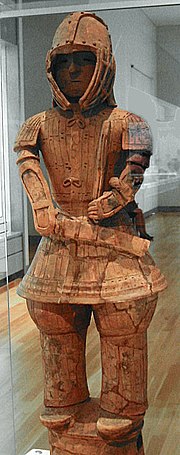Portal:Ancient Japan/Selected lists/4
| This page is currently inactive and is retained for historical reference. Either the page is no longer relevant or consensus on its purpose has become unclear. To revive discussion, seek broader input via a forum such as the village pump. |

The term "National Treasure" has been used in Japan to denote cultural properties since 1897. The definition and the criteria have changed since the inception of the term. The weapons in this list of archaeological materials designated as National Treasures of Japan span a period from about 4,500 BC to 1361 AD. The Japanese Paleolithic marks the beginning of human habitation in Japan. It is generally accepted that human settlement did not occur before 38,000 BC. Archaeological artifacts from the paleolithic era consist of stone tools of various types. From about 14,000 to 8,000 BC, the society gradually transformed to one characterized by the creation of pottery used for storage, cooking, bone burial and possibly ceremonial purposes. Dogū—small clay figurines depicting humans and animals—can be dated to the earliest Jōmon period but their prevalence increased dramatically in the middle Jōmon. Three dogū from 3000 to 1000 BC have been designated as National Treasures. The ensuing Yayoi period is characterized by great technological advances such as wet-rice agriculture or bronze and iron casting, which were introduced from the mainland. Iron knives and axes, followed by bronze swords, spears and mirrors, were brought to Japan from Korea and China. The primary artistic artifacts, with the exception of Yayoi pottery, are bronze weapons, such as swords, halberds and dōtaku, ritual bells. In addition ornamental jewels were found. The starting date of the Kofun period (c. 250–300 AD) is defined by the appearance of large-scale keyhole-shaped kofun mound tombs, thought to mark imperial burials. Typical burial goods include mirrors, beads, Korean Sue ware, weapons and later horse gear. Mirrors, swords and curved jewels, which constitute the Imperial Regalia of Japan, appear as early as the middle Yayoi period, and are abundant in Kofun period tombs. Characteristic of most kofun are haniwa clay terra cotta figures whose origin and purpose is unknown. A haniwa of an armoured man has been designated as National Treasure; and a 1st-century gold seal, designated a National Treasure, shows one of the earliest mentions of Japan or Wa.
